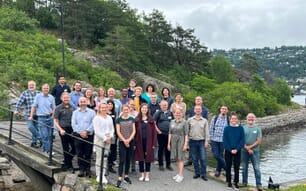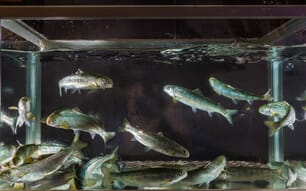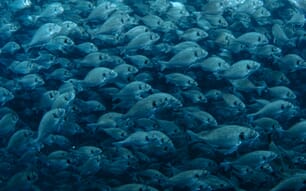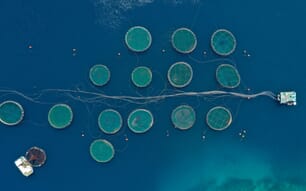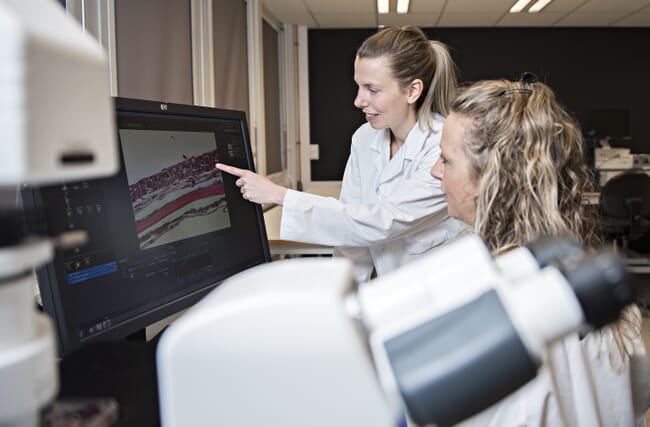
Artificial intelligence is a comprehensive branch of computer science where machines are trained to perform tasks that usually require human intelligence. The machines know nothing from the start, but they can be trained to recognise highly complex patterns.
At Nofima we have developed an AI package for the evaluation of salmon skin - the health of which is vital to the health of the whole fish - using the commercial Aiforia platform. In order to train the algorithm, we used several different sample sets, from 100 g smolt to 5 kg salmon that are ready for slaughter. This resulted in a unique AI-model that is able to measure salmon skin structures.
Many more samples
Skin is a type of tissue that is eminently suitable for machine learning as it consists of several different layers and cells in varying shapes, and sizes. The outermost skin layer, the epidermis is important for the health of the fish, as it seals the skin in order to prevent it from leaking, and is also involved in fighting off bacteria and viruses. This part of the skin also produces mucous, which acts as a protective layer around the fish. The subcutaneous tissue consists of scales and connective tissue which are important for the swimming movements and flexibility of the fish. All of these components were included in the AI-model, and during the course of 2020 nearly 1,000 images were analysed using machine learning.
Using the skin analysis AI software, we tested skin from salmon produced at a commercial location in northern Norway. With the help of the AI-model, we analysed many more samples than would normally have been possible when using manual methods, providing a far larger data set, and thus more reliable sample responses.
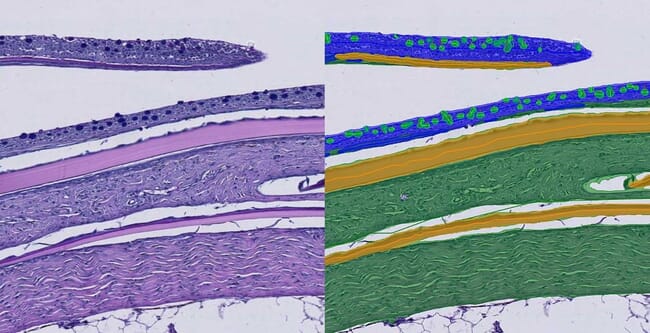
Mortality and skin quality
The AI results from commercial fish from the northern part of Norway, taught us that the dynamics of the skin’s epidermis and subcutaneous tissue are different. The dermis grows steadily as the fish develop. This means that the skin becomes thicker as the fish grows, something which in turn is important for its mechanical functions. The outer layer of skin, epidermis, is not connected to the growth of the fish. On the other hand, the structure of this layer changes in line with the external environment, for example if the temperature changes.
We were also able to establish further connections between mortality and skin quality. The mortality rate was highest during the first few weeks following transfer to sea, and it increased after transport and towards the end of the production cycle, when the fish were more often exposed to mechanical delousing. The mortality rate coincided with various structural impairments in the skin of the salmon. We know from previous studies that transfer to the sea weakens the skin's immune system (Karlsen et al., 2018), and even superficial wounds (loss of mucous and scales) in healthy fish increase the risk of infection.
Future use of the AI model
Based on our analyses and previous studies on wound healing, it would appear that the skin is able to withstand some injuries and heal quickly. But we still know very little about the effects of repeated mechanical treatments on the skin's ability to repair itself, or what percentage of scale loss causes problems with regulating the salt balance in the fish. More targeted scientific work is required in order to find out the thresholds for scale loss and skin damage for fish in the sea, and not least, how various forms of mechanical delousing and repeated treatments affect fish skin quality over time.
Having now used the software for several projects, we are starting to form an idea about what the skin of a healthy fish should be like. In order to obtain a better overview on general fish health, we have gone one step further and developed similar AI algorithms for the liver and gills. Our long-term goal is to create large, reproducible datasets for many organs, to better understand the relationships between the health of the organs, the production data and the way in which the fish have been treated. Such analyses will enable us to evaluate fish health in a more holistic and more intelligent way in the future.

